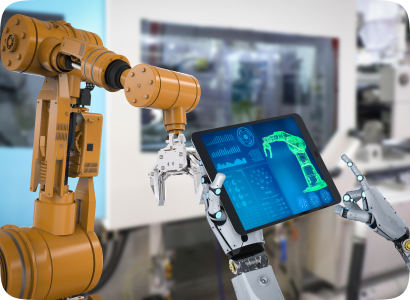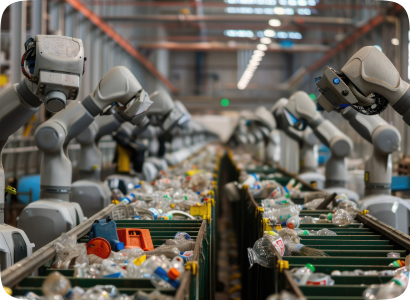IT Solutions for Manufacturing
The era of modernizing manufacturing operations isn’t just on the horizon—it’s already here. In fact, we’ve moved past the point of planning; we’re in a phase of urgency. The need for cutting-edge Manufacturing IT solutions has never been greater. Are you ready to take the leap?

Engineering Digital Transformation Across Manufacturing Verticals
- Digital Twin Development for real-time prototyping and monitoring
- Predictive Maintenance using IoT sensors and machine learning
- Production Line Automation through AI-integrated PLC systems
- MES (Manufacturing Execution System) Integration
- Quality Control Automation using Computer Vision
- Batch Process Optimization with AI and real-time analytics
- SCADA System Integration for plant-level control
- Compliance and Regulatory Automation (FDA, ISO, etc.)
- Waste Reduction using AI-driven yield forecasting
- Recipe and Formula Management Systems
- IoT-Powered Asset Tracking and Health Monitoring
- Digital Product Lifecycle Management (PLM) platforms
- Remote Support and Diagnostics via AR/VR
- ERP and CRM Integration for Supply Chain Efficiency
- Predictive Analytics for spare parts planning
- Smart Factory Enablement with AI + IoT
- Demand Forecasting using Generative AI models
- Real-Time Supply Chain Visibility Platforms
- CAD Integration and 3D Apparel Simulation
- Automated Defect Detection using Machine Vision
- SCADA & HMI System Development
- Smart Grid and Energy Analytics Dashboards
- Asset Lifecycle Management Systems
- Condition Monitoring Systems for Transformers and Panels
- Digital Compliance and Emissions Tracking
- Intelligent Packaging Lines with ML-driven QC
- Warehouse and Distribution Automation
- Sustainability Analytics for ESG Reporting
- Connected Factory IoT Platform
- Customer Feedback Loops via AI Bots
Wondering if technology solutions will coexist with your current infrastructure? Talk to consultants.
Driving Smart Transformation with IoT in Manufacturing Industry
Harness the power of connected devices, real-time data, and intelligent automation to transform manufacturing operations from the ground up.
IoT sensors continuously monitor machine health, detecting anomalies and performance drops before failures occur. This helps manufacturers reduce downtime and optimize maintenance schedules. By moving from reactive to proactive maintenance, plants avoid unplanned outages and extend asset lifespan. This not only improves productivity but also lowers long-term maintenance costs.
- Vibration & temp monitoring
- Real-time alerts for part degradation
- Predictive analytics for failure
- Maintenance scheduling
- Integration with CMMS
- Real-time remote diagnostics
Connected devices and RFID sensors enable real-time visibility of assets across the supply chain, improving inventory accuracy, traceability, and equipment utilization. By knowing exactly where each asset is and how it’s being used, manufacturers can reduce losses, increase throughput, and streamline operations. IoT-based asset tracking brings greater transparency and accountability to floor-level operations.
- Real-time location tracking of tools
- RFID inventory monitoring
- Usage tracking for shared equipment
- Asset health monitoring
- Loss prevention via geofencing
- Depreciation tracking
IoT-based energy monitoring systems track consumption across production lines and facilities, enabling better energy efficiency, cost control, and sustainability compliance. With granular insights into energy patterns, manufacturers can identify waste points, optimize machine usage, and meet sustainability goals. This data-driven approach helps reduce carbon footprint and operational expenses.
- Energy consumption dashboards
- Load forecasting and optimization
- Smart lighting and HVAC control
- Automated energy usage alerts
- Green energy sources integration
- Sustainability reporting
IoT enhances every stage of production by capturing data from machines, operators, and environments, enabling data-driven process improvements and reduced waste. By analyzing this continuous data stream, manufacturers can dynamically adjust workflows, improve throughput, and detect quality issues in real time. It creates a more agile, efficient, and responsive production environment.
- Machine performance
- Production output monitoring
- Sensor-based inspection
- Cycle time analytics
- Operator performance
- Adaptive manufacturing
From Data to Decisions: Manufacturing Data Analytics Solutions
From machine sensors to supply chain logs, analyzing the right manufacturing data unlocks higher efficiency, reduced downtime, and smarter decision-making.
Sensor Data Analysis
Data Analysis
Data Analysis
Data Analysis
Data Analysis
Procurement Data Analysis
Shift Data Analysis
AI in Manufacturing Industry: Powering Precision, Performance & Prediction
From predictive quality checks to autonomous decision-making, AI in manufacturing enhances every stage of production. It brings unmatched precision, optimizes performance, and enables real-time predictions that drive smarter, faster operations.

Auto-generates design variations based on performance goals.
Suggests material-efficient structures without compromising strength.
Simulates real-world testing digitally to reduce physical prototyping.
Predicts how designs behave under stress or extreme conditions.
Recommends optimal materials based on use cases and cost.
Learns from past design outcomes to improve future iterations.

Adapt actions based on real-time human presence and behavior.
Allow hands-free, intuitive control of robotic systems.
Cobots learn tasks by observing humans.
Detects and prevents unsafe proximity in shared workspaces.
Adjusts effort distribution between humans and machines.
Analyzes joint workflows for speed, accuracy, and ergonomics.

Automatically builds custom product variants per user input.
Uses buyer preferences to influence future product features.
Instantly creates accurate bills of materials for custom builds.
Adjusts product pricing dynamically based on customizations.
AI adapts lines for different custom variants on the fly.
Refines product features based on customer trends.

Detects recurring causes of material wastage in production.
Reduces environmental footprint through smart dosing.
Suggests eco-friendly packaging with material optimization.
Monitors and forecasts carbon output at every process stage.
Visualizes ESG metrics and alerts for deviation.
Uses AI to predict long-term environmental effects of product decisions.

AI Agents in Manufacturing
- Predicts failures and schedules maintenance automatically.
- Auto-adjusts production plans in real time.
- Optimizes energy use by controlling idle systems.
- Rebalances supply chain based on live disruptions.
- Identifies bottlenecks across the production line.
- Minimizes waste by adjusting machine parameters live.
- Forecasts demand to fine-tune production volumes.
Our 4-Step Digital Transformation in Manufacturing Strategy
Audit
Governance
Integration
Framework
Infrastructure
Flow
Analytics
Platforms
Computing
Chain
AI
Automation
Systems
Personalization
AI
Tracking
Enhancement
Maintenance
Metrics
Loops
Our Talent Solution and Value System for Manufacturing IT Solutions

Architects
Managers
Engineers
Specialists
Developers
Engineers
- Increased Efficiency
- Enhanced Productivity
- Improved Quality
- Scalability
- Faster Time-to-Market
- Cost Savings
- Optimized Cloud Infrastructure
- Sustainability
- Efficient CI/CD Pipelines
- Market Competitiveness
- Innovation Enablement
- Robust Security
- Interoperability
- System Reliability
- Cloud Flexibility
Explore Our Case Studies Around Data, Cloud, DevOps, IoT & AI
Frequently Asked Questions (FAQ's)
AI brings intelligence to your operations, it predicts machine failures before they happen, helps spot production inefficiencies, improves product quality with real-time analysis, and even automates routine decisions. It’s like giving your factory a brain that learns and optimizes continuously.
You can analyze machine sensor data, production throughput, quality control records, energy consumption, workforce productivity, inventory levels, you name it. When combined and visualized, this data helps you make smarter, faster decisions and uncover opportunities you didn’t know existed.
Not at all! IoT can be customized for small, mid-sized, or large operations. Even a few connected sensors and dashboards can deliver immediate value, like reducing downtime or tracking energy use, without needing a massive investment upfront.
You can start seeing results in a few weeks depending on the solution. For example, predictive maintenance and real-time production monitoring often show early wins, while more complex AI models may take a few months. It’s all about quick wins first, then scaling impact.
Yes, automation follows rules, but AI learns and adapts. Think of AI as the next level: it helps machines make smarter decisions, optimize processes on the fly, and react to changing inputs without needing human intervention every time.
Definitely. Most AI and IoT platforms are designed to integrate seamlessly with systems like ERP, MES, SCADA, or even legacy databases. That means you don’t have to replace your current tech—you just make it smarter.
Regular maintenance follows a fixed schedule, whether the machine needs it or not. Predictive maintenance, powered by AI and IoT, monitors real-time data like temperature, vibration, and usage patterns to predict issues before they happen. It helps you avoid unnecessary downtime and costly breakdowns.
Absolutely! AI can analyze thousands of product images or data points to catch even the smallest defects in real time. It learns from past quality issues, reduces human error, and ensures consistent standards, meaning fewer returns, less scrap, and happier customers.
AI helps pinpoint where material, energy, or time is being wasted by continuously analyzing production data. It can recommend process adjustments, detect bottlenecks, and even optimize how raw materials are used, leading to more sustainable and cost-effective operations.
ROI comes from multiple angles, reduced downtime, higher product quality, fewer defects, lower energy costs, and better forecasting. We help you set measurable goals and KPIs from the start so you can track exactly how the investment performs over time.




 AI-powered responses • Regional expertise • Sourced information
AI-powered responses • Regional expertise • Sourced information























 Talk to Our
Consultants
Talk to Our
Consultants Chat with
Our Experts
Chat with
Our Experts Write us
an Email
Write us
an Email







